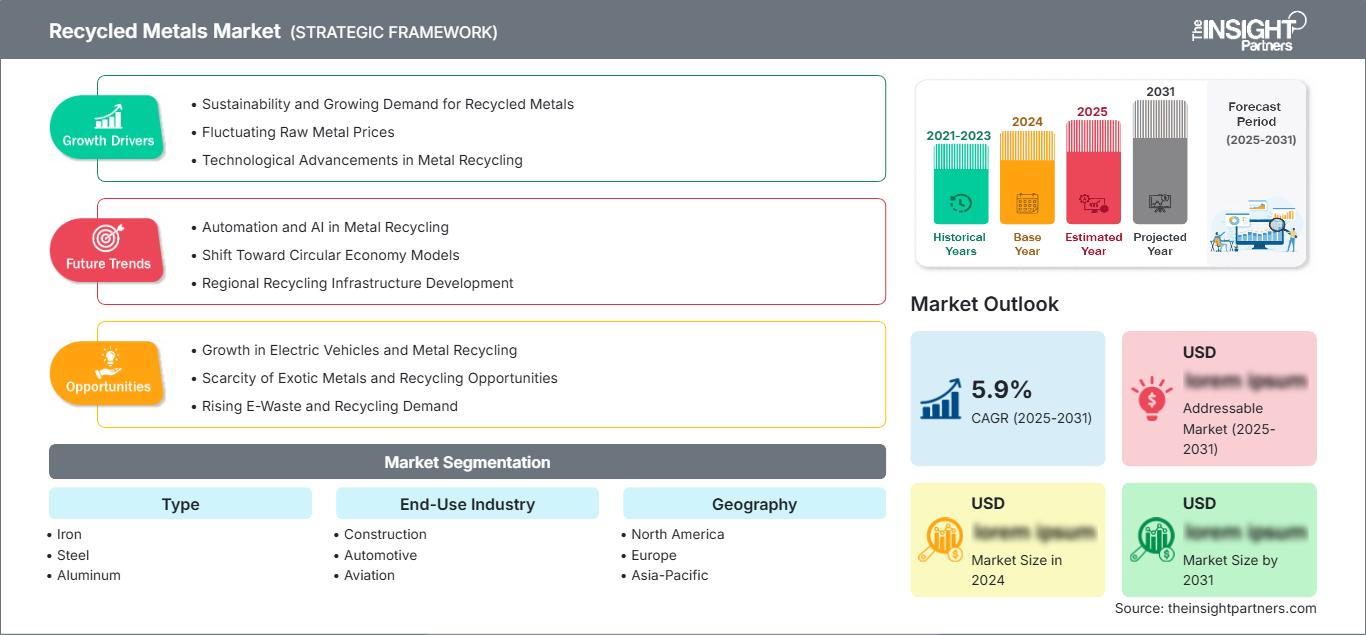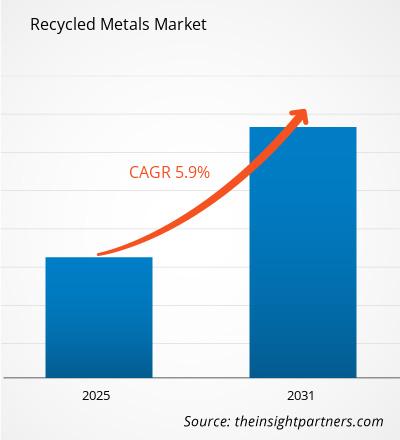Se espera que el tamaño del mercado de metales reciclados alcance los 502.310 millones de dólares estadounidenses para 2031. Se anticipa que el mercado registre una CAGR del 3,6 % durante 2025-2031.
El informe está segmentado por tipo (hierro, acero, aluminio, cobre, níquel, platino, plomo, estaño y otros). Además, se segmenta por industria de uso final (construcción, automoción, aviación, bienes de consumo duraderos, maquinaria industrial, embalaje, entre otros). El informe abarca cinco regiones: Norteamérica, Europa, Asia Pacífico, Oriente Medio y África, y Sudamérica y Centroamérica, así como los países clave de cada región. El análisis global se desglosa a nivel regional y por países principales. El informe ofrece el valor en USD para el análisis y los segmentos mencionados.
Propósito del Informe
El informe "Mercado de Metales Reciclados" de The Insight Partners busca describir el panorama actual y el crecimiento futuro, los principales factores impulsores, los desafíos y las oportunidades. Esto proporcionará información a diversas partes interesadas del negocio, como:
- Proveedores/fabricantes de tecnología: Para comprender la dinámica cambiante del mercado y conocer las oportunidades potenciales de crecimiento, lo que les permitirá tomar decisiones estratégicas informadas.
- Inversores: Realizar un análisis exhaustivo de tendencias respecto a la tasa de crecimiento del mercado, las proyecciones financieras del mercado y las oportunidades que existen en toda la cadena de valor.
- Órganos reguladores: Regular las políticas y las actividades policiales en el mercado con el objetivo de minimizar el abuso, preservar la confianza de los inversores y defender la integridad y estabilidad del mercado.
Segmentación del mercado de metales reciclados
- Hierro
- Acero
- Aluminio
- Cobre
- Níquel
- Platino
- Dirigir
- Estaño
Industria de uso final
- Construcción
- Automotor
- Aviación
- Bienes de consumo duraderos
- Maquinaria industrial
- Embalaje
Obtendrá personalización en cualquier informe, sin cargo, incluidas partes de este informe o análisis a nivel de país, paquete de datos de Excel, así como también grandes ofertas y descuentos para empresas emergentes y universidades.
Mercado de metales reciclados: perspectivas estratégicas

-
Obtenga las principales tendencias clave del mercado de este informe.Esta muestra GRATUITA incluirá análisis de datos, desde tendencias del mercado hasta estimaciones y pronósticos.
Factores que impulsan el crecimiento del mercado de metales reciclados
- Sostenibilidad y creciente demanda de metales reciclados: A medida que crece la conciencia ambiental, la sostenibilidad está en boca de todos en las industrias actuales. Gobiernos, empresas y consumidores se muestran cada vez más respetuosos con el medio ambiente, lo que impulsa la demanda de metales reciclados. El reciclaje metalúrgico conserva los recursos naturales, ahorra energía y reduce los efectos de la degradación ambiental. Regulaciones como los impuestos al carbono y las normas de gestión de residuos incentivan a las empresas a adoptar modelos de economía circular, impulsando la demanda de metales reciclados como alternativa ecológica a los metales vírgenes.
- Precios fluctuantes de las materias primas: Las fluctuaciones globales en el precio de los metales vírgenes (aluminio, cobre y acero) suelen afectar la demanda de metales reciclados. Cuando la extracción de metales en bruto se vuelve demasiado cara, conviene reciclarlos. La tendencia más reciente de este fenómeno se observa en las industrias automotriz y de la construcción, donde la demanda de metales se mantiene alta y el reciclaje de metales ofrece una ventaja de precio, además de la sostenibilidad. El reciclaje brindará estabilidad a las empresas con precios fluctuantes de los metales, ya que ofrece una cadena de suministro más económica.
- Avances tecnológicos en el reciclaje de metales: Los avances tecnológicos en el reciclaje de metales hacen que los procesos sean más eficientes y generan productos de mayor calidad. Las técnicas mejoradas de clasificación permiten un mejor uso de la separación automatizada y una fundición más eficaz, lo que garantiza una mayor pureza y rendimiento de los metales a reciclar. Las innovaciones en esta tecnología han hecho que el reciclaje sea más rentable, permitiendo que más industrias utilicen los metales reciclados disponibles en aplicaciones de alta gama, como la electrónica y el sector automotriz, que requieren una gran integridad de los materiales. Las nuevas tecnologías de reciclaje hacen que la extracción de metales preciosos sea más económica, lo que mejora el mercado en general.
Tendencias futuras del mercado de metales reciclados
- Automatización e IA en el Reciclaje de Metales: La automatización y las tecnologías de IA se están incorporando a la industria del reciclaje de metales para optimizar la clasificación, el procesamiento y el transporte de chatarra. Los sistemas de clasificación automatizados basados en IA y aprendizaje automático mejoran la identificación de metales con mayor precisión, lo que mejora la calidad de los materiales reciclados y reduce los costos operativos. Las innovaciones derivadas de estos avances hacen que el proceso de reciclaje sea más rápido y seguro, un atractivo que tanto los grandes recicladores como las pequeñas empresas aprecian.
- Transición hacia modelos de economía circular: Cada vez más industrias se están orientando hacia el modelo de economía circular, en el que no solo reciclan chatarra, sino que también diseñan productos más fáciles de reciclar. Esto ocurre en muchos sectores, como la electrónica, la automoción y el embalaje, donde los productores integran metales reciclables en sus diseños. Las empresas han adoptado programas de recogida para recoger productos usados y reciclarlos. Esta transición hacia una economía circular ha beneficiado al mercado del metal reciclado, aumentando la oferta de chatarra para reciclar.
- Desarrollo de Infraestructura Regional de Reciclaje: La infraestructura regional de reciclaje cobra una importancia cada vez mayor en el mercado del metal reciclado, y los países, en particular los de la Unión Europea y América del Norte, están trabajando para desarrollar capacidades internas de reciclaje más significativas para reducir su dependencia de la chatarra importada. Esta tendencia regional también va de la mano con la creciente importancia que se otorga a la reducción de los costos de transporte y la reducción de la huella de carbono derivada del transporte de chatarra a través de las fronteras nacionales.
Oportunidades de mercado de metales reciclados
- Crecimiento de vehículos eléctricos y reciclaje de metales: El crecimiento de los vehículos eléctricos se observa a nivel mundial, lo que incrementa la demanda de aluminio, cobre y litio. Estos metales se utilizan en los vehículos eléctricos, especialmente en sus baterías y motores, así como en muchos componentes de la carrocería diseñados para reducir el peso de los vehículos. Su reciclaje puede ser una oportunidad para abordar la creciente demanda de forma respetuosa con el medio ambiente. Es necesario aumentar la disponibilidad de metales reciclados para complementar los suministros extraídos y, en consecuencia, mitigar los efectos de la extracción de dichos metales.
- Escasez de metales exóticos y oportunidades de reciclaje: El creciente consumo de metales escasos y exóticos, como el litio, el cobalto y las tierras raras, en productos electrónicos y equipos de energía renovable, generará un nuevo mercado para el sector del reciclaje. Actualmente no existen procesos de reciclaje disponibles para estos metales, pero a medida que la tecnología avance, podrían surgir nuevas tecnologías viables para reciclar económicamente estos materiales a partir de productos electrónicos al final de su vida útil, baterías usadas e infraestructura de energía renovable. Esto establecería una nueva fuente de ingresos para el mercado de metales reciclados y contribuiría a la transición mundial hacia energías más limpias.
- Aumento de la demanda de residuos electrónicos y reciclaje: Dado el aumento global del volumen de residuos electrónicos, existe un amplio margen para el reciclaje de metales en los productos electrónicos de consumo desechados. Entre los metales presentes en los residuos electrónicos se incluyen el oro, la plata, el cobre y el paladio. Las regulaciones, junto con una mayor concienciación de los consumidores, impulsarían la mejora de los métodos de reciclaje de residuos electrónicos, lo que proporcionaría una fuente de metales muy necesaria para el mundo, además de abordar los problemas ambientales derivados de la generación de residuos electrónicos. A medida que los países avanzan hacia una legislación más estricta sobre el reciclaje de residuos electrónicos, más empresas especializadas en este nicho pueden captar una mayor cuota de mercado.
Perspectivas regionales del mercado de metales reciclados
Los analistas de The Insight Partners han explicado detalladamente las tendencias regionales y los factores que influyen en el mercado de metales reciclados durante el período de pronóstico. Esta sección también analiza los segmentos y la geografía del mercado de metales reciclados en América del Norte, Europa, Asia Pacífico, Oriente Medio y África, y América del Sur y Central.
Alcance del informe del mercado de metales reciclados
| Atributo del informe | Detalles |
|---|---|
| Tamaño del mercado en 2024 | XX mil millones de dólares estadounidenses |
| Tamaño del mercado en 2031 | 502.310 millones de dólares estadounidenses |
| CAGR global (2025-2031) | 3,6% |
| Datos históricos | 2021-2023 |
| Período de pronóstico | 2025-2031 |
| Segmentos cubiertos |
Por tipo
|
| Regiones y países cubiertos |
América del norte
|
| Líderes del mercado y perfiles de empresas clave |
|
Densidad de actores del mercado de metales reciclados: comprensión de su impacto en la dinámica empresarial
El mercado de metales reciclados está creciendo rápidamente, impulsado por la creciente demanda del usuario final debido a factores como la evolución de las preferencias de los consumidores, los avances tecnológicos y una mayor conciencia de los beneficios del producto. A medida que aumenta la demanda, las empresas amplían su oferta, innovan para satisfacer las necesidades de los consumidores y aprovechan las tendencias emergentes, lo que impulsa aún más el crecimiento del mercado.

- Obtenga una descripción general de los principales actores clave del mercado de metales reciclados
Puntos clave de venta
- Cobertura integral: el informe cubre exhaustivamente el análisis de productos, servicios, tipos y usuarios finales del mercado de metales reciclados, proporcionando un panorama holístico.
- Análisis de expertos: el informe se compila con base en el conocimiento profundo de expertos y analistas de la industria.
- Información actualizada: El informe asegura relevancia comercial debido a su cobertura de información reciente y tendencias de datos.
- Opciones de personalización: este informe se puede personalizar para satisfacer los requisitos específicos del cliente y adaptarse adecuadamente a las estrategias comerciales.
Por lo tanto, el informe de investigación sobre el mercado de metales reciclados puede ayudar a descifrar y comprender el panorama de la industria y sus perspectivas de crecimiento. Si bien existen algunas preocupaciones válidas, las ventajas generales de este informe tienden a superar las desventajas.
- Análisis histórico (2 años), año base, pronóstico (7 años) con CAGR
- Análisis PEST y FODA
- Tamaño del mercado, valor/volumen: global, regional y nacional
- Industria y panorama competitivo
- Conjunto de datos de Excel
Informes recientes
Testimonios
Razón para comprar
- Toma de decisiones informada
- Comprensión de la dinámica del mercado
- Análisis competitivo
- Información sobre clientes
- Pronósticos del mercado
- Mitigación de riesgos
- Planificación estratégica
- Justificación de la inversión
- Identificación de mercados emergentes
- Mejora de las estrategias de marketing
- Impulso de la eficiencia operativa
- Alineación con las tendencias regulatorias






















 Obtenga una muestra gratuita para - Mercado de metales reciclados
Obtenga una muestra gratuita para - Mercado de metales reciclados